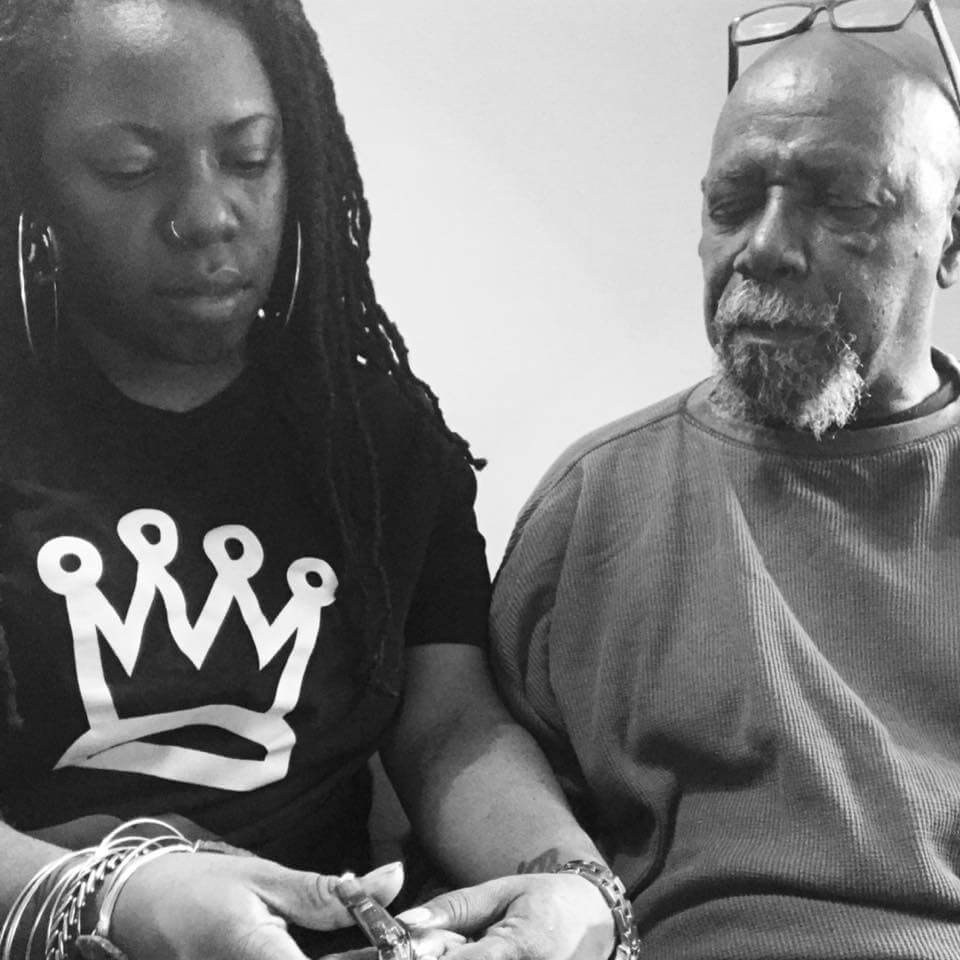
#image_title
Many people believe Medicare will cover long-term care costs, such as fees associated with going into a nursing home. It doesn’t.
Every morning, Joy Randall starts her day by making her father a cup of coffee. Once he’s caffeinated, their daily routine begins. She helps her father get dressed, takes him to and from dialysis and doctors appointments, manages his medicine, and prepares his meals. It’s a routine they’ve honed after 18 months of living together again.
A successful makeup artist, Randall put her career on hold in 2018 so that she could take care of her ailing father. The 38-year-old uprooted her life in Charlotte, North Carolina—a city she’d called home her entire life—to move to a small, rural town about 40 minutes north of Raleigh called Henderson. There, she manages her father’s complex array of medical issues.
Randall’s father is 73 years old and suffers from diabetes, which has led to several complications. Among them are glaucoma, which has blinded him; a partial amputation of his foot; and kidney failure, for which he needs dialysis.
Randall said she made the choice to care for her father because there were few other options available. Her father is a veteran and worked in the education system—meaning he has a retirement plan—but he’s not wealthy enough to afford full-time home care and he’s not poor enough to qualify for Medicaid, which would cover many of his long-term care needs.
“He makes too much money,” Randall said.
Randall’s father is, however, on Medicare. But as he and an increasing number of families are finding out, the program doesn’t cover nearly as much as most Americans think.
Enacted as part of the Social Security Act in 1965, Medicare is the nation’s federal health insurance program for Americans who are 65 or older. It covers hospital stays, doctors’ services, outpatient care, and some drug costs, but the program offers very limited care for long-term illnesses or diseases, such as Parkinson’s, Alzheimer’s, or dementia. In most circumstances, Medicare also fails to cover in-home services, such as meal delivery and bathing, for chronically ill seniors like Randall’s father.
“The myth is that Medicare will cover long-term care needs. Most Americans think that’s the case, but that is not the case.”
“The myth is that Medicare will cover long-term care needs. Most Americans think that’s the case, but that is not the case,” said Lynn Feinberg, senior strategic policy advisor at the AARP Public Policy Institute. “Medicare provides very limited help if one goes into a rehab facility after you have a hip replacement, for example, but it doesn’t cover a regular nursing home and most people believe it does cover that.”
Sandra Levitsky, a sociology professor at the University of Michigan, said this myth is pervasive and shocks many Americans when they first find out about it.
“I’ve sat in on support groups for family caregivers, and as new people joined these support groups, there was always this period of astonishment at how little Medicare covers,” Levitsky said.
This “information black hole,” as Levitsky calls it, is only part of the growing elder care crisis in the United States.
The need for long-term care
The U.S. is one of only two developed countries in the world without a social insurance program for long-term care. Private long-term care plans can cost several thousand dollars per year, putting them out of reach for many Americans. Only about 7.2 million Americans have long-term care insurance, according to the AARP, and the cost of premiums continue to rise, reducing demand.
The lack of a public program and an affordable private program presents an enormous problem for a rapidly aging nation that, thanks to improvements in medical technology and public health, is living much longer than it did a hundred years ago.
In 2018, there were 52 million people aged 65 and older, according to the U.S. Census Bureau. By the mid 2030s, that number will surge to 78 million, and Americans over 65 will outnumber children under 18 for the first time in the country’s history, according to Census projections.

[Source: U.S. Census Bureau]
Aging baby boomers aren’t the only reason for America’s growing care crisis. In recent decades, women who have historically been far more likely to serve as caretakers have entered the labor force in increasing numbers. This shift in demographics and household structures is creating a “care gap,” whereby there aren’t enough caretakers or care workers to take care of America’s aging population—a group that will need more help than ever before.
Studies indicate that more than half of older Americans will eventually require long-term care, with the average lifetime long-term care costs for Americans over age 65 reaching $138,000, according to a 2016 study by the Urban Institute. For 15 percent of those seniors, those costs will reach at least a quarter of a million dollars.
“That is vastly more than nearly all Americans have,” Howard Gleckman, senior fellow at the Urban Institute, told COURIER.
The median household income in households led by someone 65 or older in the United States in 2018 was $43,696, according to the Census Bureau, while the median net worth for American families ages 65 to 74 is $224,100. For families 75 or older, that number rises to $264,800.
That may sound like a lot, but it’s “not nearly enough” to pay for long-term care, Gleckman said. Full-time home care costs more than $50,000 per year and the median annual cost of a private room in a nursing home is more than $100,000, according to the AARP.
Wealthy individuals can afford the help they need and Medicaid covers the very poor and disabled, but experts say the vast majority of middle- and working-class Americans are left without any options.
Millions of Americans, including Randall’s father, fall into this category, a group dubbed “The Forgotten Middle” by the authors of a 2019 study published in Health Affairs.
By 2029, according to the study, there will be 14.4 million middle-income seniors, and more than half will have mobility limitations. The authors also estimate that 20 percent will have high healthcare and functional needs.
“While many of these seniors will likely need the level of care provided in seniors housing, we project that 54 percent of seniors will not have sufficient financial resources to pay for it,” the study states.
The study’s findings echo Gleckman’s analysis of the current elder care system.
“The financial resources are not there, the public programs don’t exist, to be eligible for Medicaid, you need to be very sick and impoverished, and to self-insure for a risk like this, a couple probably needs a million dollars,” Gleckman said. “So what do you do? You rely on your children, you rely on your friends, and then you rely on nobody.”
The toll of caring for an elderly family member
Under the nation’s current elder care system, the responsibility for providing care most often falls on family members and friends. There are an estimated 40 million Americans providing some type of unpaid care to another adult, according to a 2018 Pew Research Center analysis of U.S. Bureau of Labor Statistics data.
On average, these adult caregivers spend about 80 minutes a day doing things like bathing, paying bills, dressing, and providing medical care and transportation, the analysis found.
The consequences of being pushed into a caregiver role are profound.

“It definitely compromises all the relationships in my life because most people do not understand the lifestyle of caregiving … there’s rarely anybody to talk to about it, so it can be very isolating,” Randall said. “Most of my friends have their own families. They cannot connect to my experience … and it makes it very challenging to have a romantic relationship.”
Caring for her father has also changed Randall’s relationship with him.
“I’ve always been extremely close to my father, he’s always been a source of laughter and happiness, but it’s definitely taken a toll,” she explained. “It changes the relationship with that parent. It bounces between that caregiver role and the parent-child role. They’re losing control of their life, so that relationship kind of suffers. They get mean.”
Her father has become depressed as he’s lost more control over his life, Randall continued, and watching him suffer has hurt her, too. “It’s just very hard to watch somebody kind of deteriorating.”
Randall’s experiences are not uncommon, particularly among women, said Janet Kim, communications director for Caring Across Generations, an organization dedicated to transforming the nation’s care infrastructure.
“The toll is financial, the toll is physical, and it is emotional, and women predominantly shoulder the burden of caring for people in our families,” Kim said.
Between 60 and 75 percent of caregivers are women, according to the AARP and the Caregiving Alliance. An estimated 11 million caregivers are also parents, falling into the so-called “sandwich generation” of caregivers who provide care for both children and elderly family members.
“It takes a toll on their role as parents and it also takes a toll on people’s mental health,” Kim said.
Roughly three in five family caregivers also hold a paying job, according to a 2016 AARP analysis, and more than half are forced to take time off from work, reduce their hours, or quit altogether.
“Withdrawing from the workforce will mean a hit on your savings and a hit on your social security. Caregivers themselves are going to get older and their futures are being put in huge jeopardy,” Kim said. “It can be financially devastating.”
The number of people who take on caregiving roles for their parents is likely to surge, just as the home care workforce grows. Home health aide is one of the fastest-growing jobs in the country, though these positions are among the lowest paid and easily exploited, Kim said.
A “slow-motion crisis”
The slow aging of America’s population, lack of affordable care options, and shifting household structures have been decades in the making, resulting in what Levitsky calls a “slow-motion crisis.” That crisis is on track to get much worse in the coming decade, which naturally leads to one question: What’s being done to address it?
In 2018, Democratic Congressman Frank Pallone of New Jersey introduced a discussion draft of a proposal to establish a public benefit within Medicare to provide long-term care services and supports, but he has yet to introduce formal legislation. Congressman Richard Neal of Massachusetts has also expressed interest in expanding long-term services, but hasn’t put forth a bill.
Several 2020 presidential candidates have introduced proposals, including former South Bend, Indiana, Mayor Pete Buttigieg and Sen. Amy Klobuchar (D-MN). Sens. Elizabeth Warren (D-MA) and Bernie Sanders (I-VT) have also championed Medicare for All plans that would incorporate some long-term care benefits.
But these proposals are unlikely to get much traction, Gleckman warned.
“There’s a growing recognition that this is a problem that has to be addressed, but there’s a broad unwillingness on the part of politicians of both political parties to pay for it,” he said. “A public long-term care insurance program is not inexpensive and politicians don’t want to raise taxes.”
“So what do you do? You rely on your children, you rely on your friends, and then you rely on nobody.”
The problem is also a cultural and social one, according to the sociologist Levitsky.
“We have this very deep and long-standing belief in our culture that taking care of our own is a family responsibility,” she said. “Most people don’t really expect the government to help until they are in a very, very dire situation, so there’s not a lot of political demand coming from the average American citizen for legislators to do something.”
Feinberg, of the AARP, thinks there’s another reason for the lack of political pressure, too.
“Most people are really in denial. Most people don’t want to think about having to depend on others for their care needs,” she said. “They certainly don’t want to burden their family and people just don’t want to think about these issues.”
Despite these obstacles, some progress is being made.
In 2017, Hawaii passed a law providing qualified caregivers with a stipend of up to $70 per day to use toward care services, and in 2019, Washington state passed the first state-level public long-term insurance program, which will provide a lifetime benefit of $36,500 to all state residents who need long-term care services. The program will be funded by a .58 percent tax on income.
Other states, including Michigan and Minnesota, have also explored similar programs, and the recent surge in state-level “paid family leave” programs gives advocates hope, too.
There’s no shortage of proposals out there. Gleckman himself convened a “Long-Term Care Financing Collaborative” that produced its own public long-term public proposal in 2016, and Caring Across Generations has also crafted its own Universal Family Care proposal, which is supported by 82 percent of Americans, according to a poll commissioned by the group.
But time is running out, says AARP’s Feinberg.
“We really need to act quickly to develop policies and programs to help people who need long-term services and support soon, because the demographics are really startling,” she said.
One thing that could spur politicians to act, Levitsky said, is a “crisis in our existing systems of health care.” Experts have pointed to a growing trend of struggling families spending down their assets until they qualify for Medicaid, which is causing the public insurance program’s spending to skyrocket.
“Medicaid is a program designed for the poor, not the middle class, and it is increasingly strained by the costs of long-term care for families who basically spend everything they have until they qualify,” Levitky said. “It’s possible that one of the things that might get the government to act is actually broken systems of social provision that are serving people they were not designed to originally serve.”
The only other options for Americans—nearly half of whom say they would have trouble covering an unexpected $400 emergency—are to set money aside over the years to use later for long-term care, or to rely on a family caretaker, such as in Randall’s case. But that’s only a short-term solution in most cases.
“Caregiving is tiring and you can only do it for so long,” Randall said. “I have to think about what my life is going to be like at whatever point he passes on. I put my career on hold as much as I could, but I have to make money, too.”

Billionaires get richer while Wisconsinites lose access to health care with ‘Beautiful Bill’
The US Senate will examine the Trump budget bill this week. It includes the largest cut to Medicaid in the program's history. It also blocks...

More ways to get birth control in Wisconsin? Sign us up.
The State Assembly has approved a plan to allow pharmacists to prescribe birth control pills and patches. There could soon be another way for women...

Opinion: Pentagon contractors don’t save lives or money – Medicaid does. Don’t cut it.
Cutting life-saving services to further enrich billionaires and Pentagon contractors is the worst possible option. This op-ed was first published on...

Opinion: Modernizing Medicare’s approach to obesity treatment is cost-effective and improves lives
Dr. Roxane Spitzer calls on Sen. Ron Johnson and his Republican colleagues to back the bipartisan initiative to expand Medicare coverage for...




